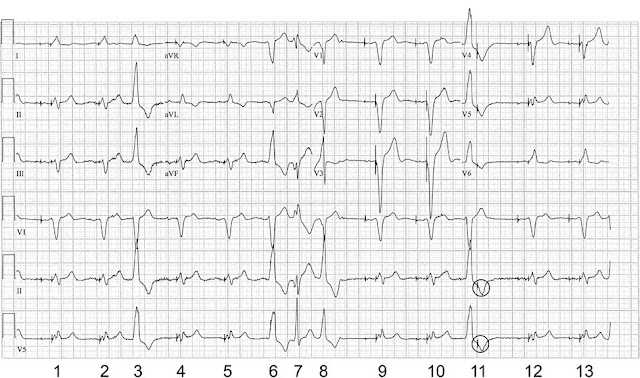We present the case of a 50-year-old man who had a dual-chamber pacemaker that was implanted because of symptomatic bradycardia. The pacemaker was programmed in a DDD mode, with a lower rate of 70 beats/min; upper rate, 120 beats/min; paced atrioventricular (AV) delay, 180 ms; sensed AV delay, 150 ms; and V-blanking period, 200 ms.
 |
Fig. 1
|
A) Ventricular undersensing with inappropriate ventricular pacing
B) Ventricular tracking of a retrograde P wave from the premature ventricular contraction
C) Ventricular event during the atrial blanking period with subsequent V-pacing
D) T-wave oversensing
E) Artifact on the electrocardiogram (ECG)—not a real pacing stimulus
Answer
C) Ventricular event during the atrial blanking period with subsequent V-pacing
In Figure 1, the ECG shows intermittent AV sequential electronic pacing (complexes 4–5 are sinus followed by electronic ventricular pacing), with premature ventricular contractions (PVCs) in the 3rd, 6th, 7th, and 8th complexes. In Figure 2, the short arrows designate the atrial-ventricular interval (A-V), which is a period that may elapse after an atrial activity before the ventricle must be paced. The long, horizontal arrows show the interval between atrial pacing.
 |
Fig. 2
|
If an atrial pacing output occurs in the presence of an already depolarized myocardium by an intrinsic premature beat (in this case, the PVC), the pacer output cannot contribute to the myocardial depolarization, and, therefore, the QRS is formed entirely by the intrinsic PVC beat. Furthermore, notice that the index PVC falls in the post-ventricular atrial blanking period (PVAB); therefore, the pacemaker was not inhibited.
Bibliography
1. Kenny T. Troubleshooter’s case book for pacemaker and ICD follow-up: fusion, pseudofusion and lots of confusion: it’s all about timing! EP Lab Digest 2005;5(9). Available from: http://www.eplabdigest.com/article/4608 [cited 2015 Nov 3].
2. Lloyd MS, El Chami MF, Langberg JJ. Pacing features that mimic malfunction: a review of current programmable and automated device functions that cause confusion in the clinical setting. J Cardiovasc Electrophysiol 2009;20(4):453-60.
3. Timperley J, Leeson P, Mitchell ARJ, Betts T. Pacemakers and ICDs (Oxford Specialist Handbooks in Cardiology). New York: Oxford University Press Inc.; 2008.
4. Tsiperfal A, Ottoboni LK, Beheiry S, Al-Ahmad A, Natale A, Wang P. Cardiac arrhythmia management: a practical guide for nurses and allied professionals. W. Sussex (UK): Wiley-Blackwell; 2011.
http://dx.doi.org/10.14503/THIJ-15-5351
Comments have closed.

No comments:
New comments are not allowed.